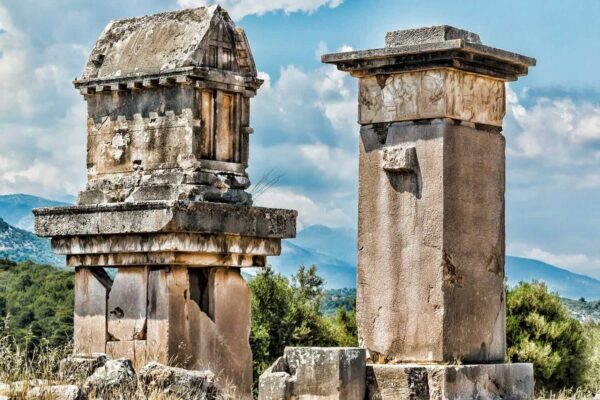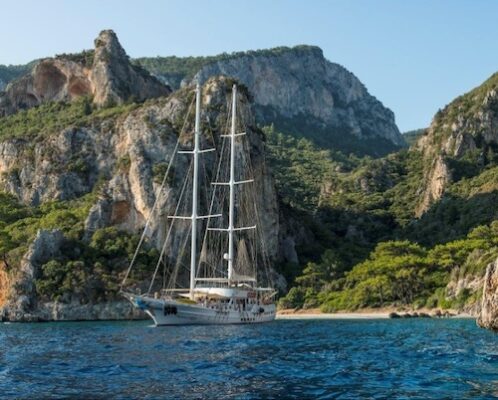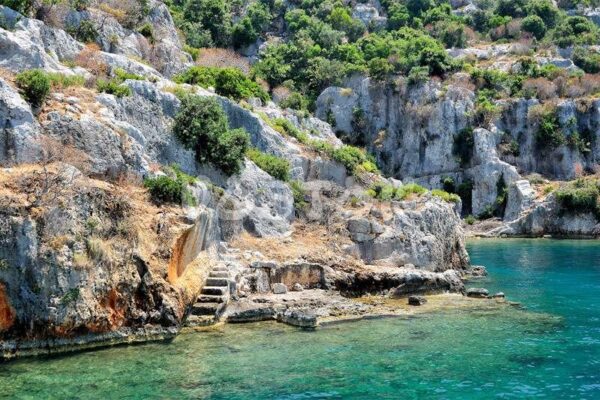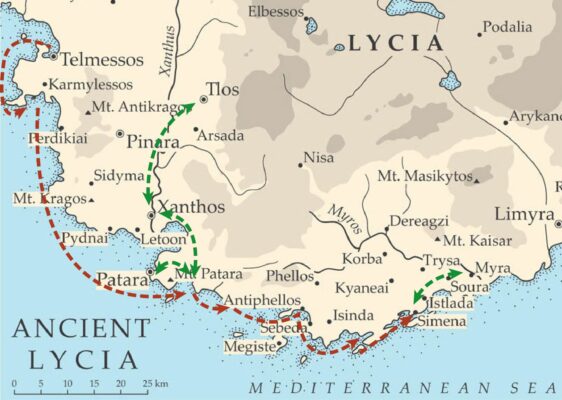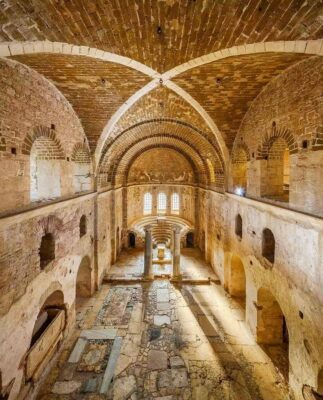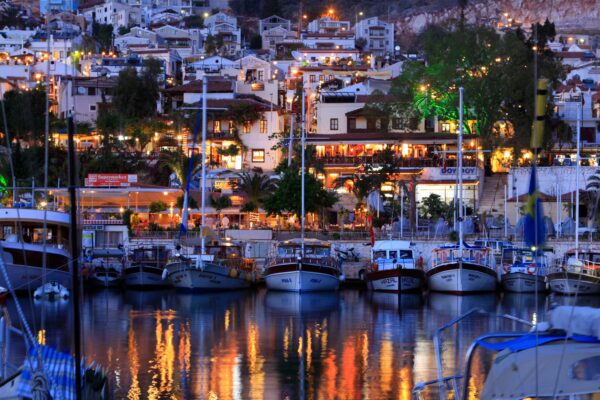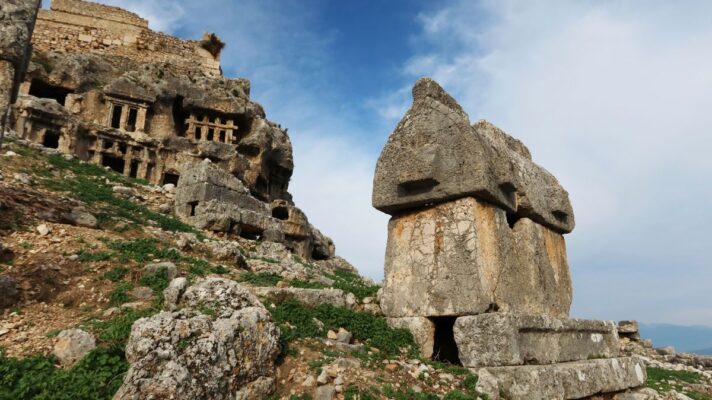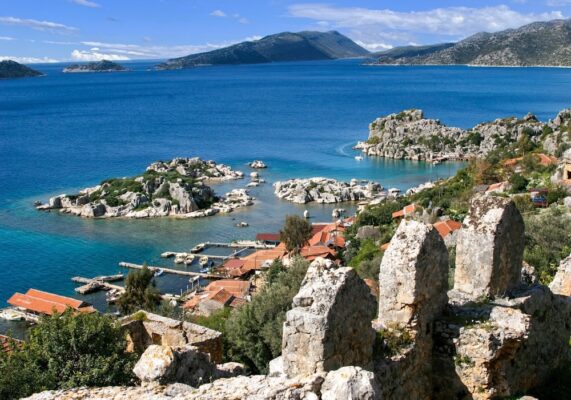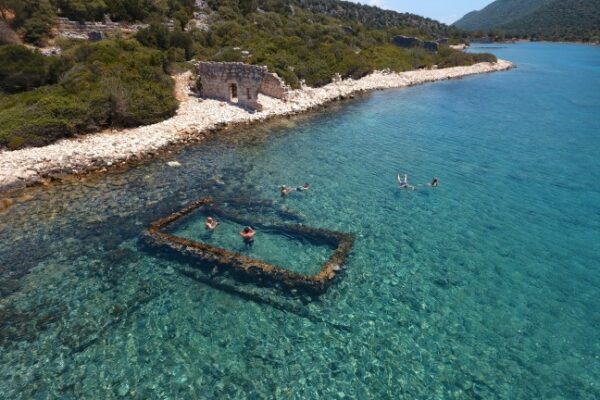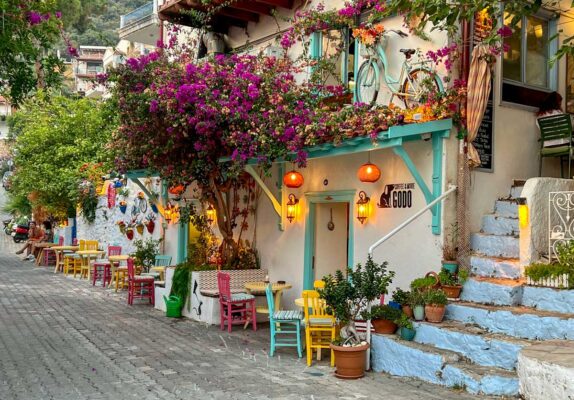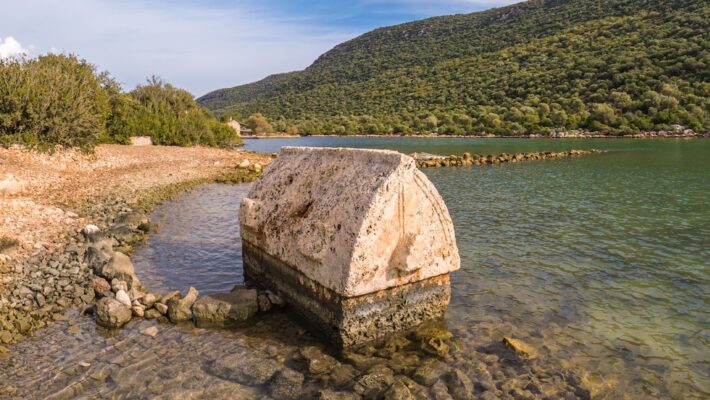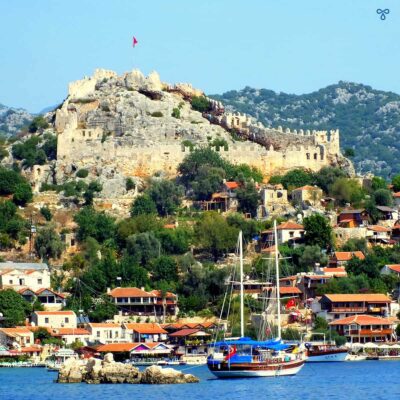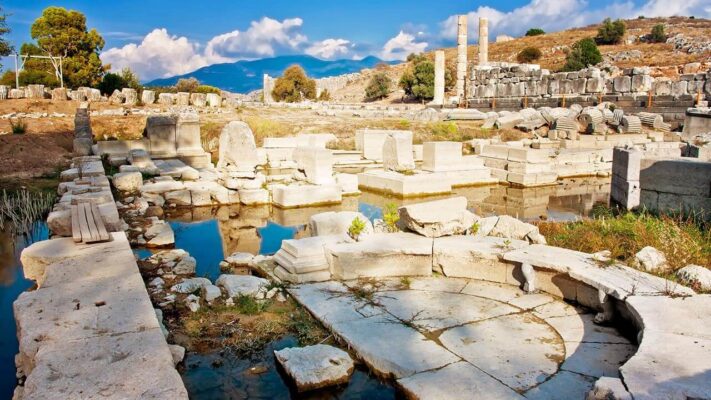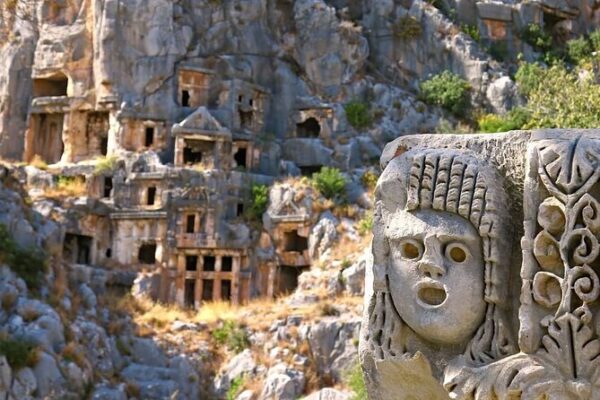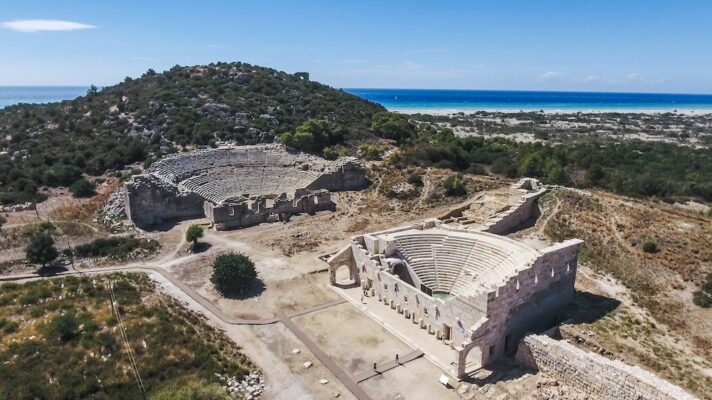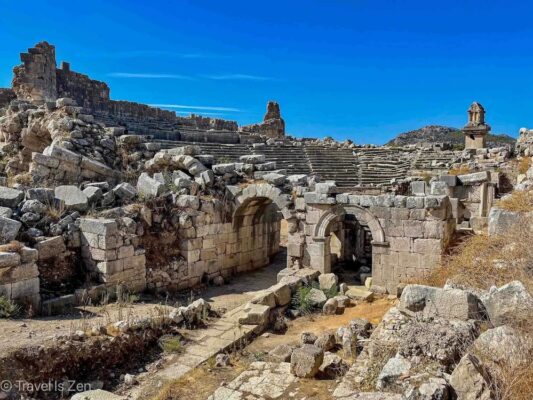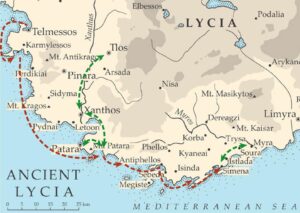Coastal Lycia
Archeology Cruise on the Turkish Coast (Fethiye-Myra-Fethiye)
Ancient Greek archeology, Byzantine architecture, coastal towns, secluded bays, ancient Greek theaters, Byzantine churches associated with St. Nicholas of Myra, swimming and snorkeling, gourmet eating and wine under the stars.
Oct 3rd-12th, 2026
Sept-Oct, 2027
Registration: SPACES AVAILABLE (Max 17 participants)
Combine with: Coastal Caria (Sept 25th - Oct 4th, 2026)
We are excited to welcome our guests to our new archeology and cruising program, "Coastal Caria" and "Coastal Lycia." These two tours will run consecutively, as we sail east from Bodrum to Fethiye on the "Coastal Caria" program, and then continue further east to Myra on the "Coastal Lycia" program. We anticipate that some guests will join us for both tours.
It is impossible to see everything in one trip, yet this trip packs in a number of the significant sites while maintaining a decidedly leisurely pace. Daily cruises transport us across turquoise waters to ancient cities, modern towns, and sheltered bays with pristine swimming and snorkeling possibilities. We include some longer optional walks. With a fantastic chef serving delicious home-cooked meals with plenty of wine, every evening will be a special night out under the stars.
September-October is the perfect time to cruise these coasts, as the water temperature is still warm enough to enjoy a swim at any time of the day or night, but the extreme temperatures of the summer have worn off. Likewise, sailing is relatively calm because the dramatic northerly winds of the Aegean Sea don't arrive until December.
Our captain has 40 years experience sailing these waters, and personally built this gulet (his fifth). He and his crew of 4 keep the boat spotlessly clean, while also attending to our guest's every need.
Many of our guests who have enjoyed our other tours will be thrilled at this opportunity. For new visitors to our company, please see our review page for a sense of what to expect. Join us, as we enter the world of ancient Mediterranean maritime travelers.
Read more about the program below.
Details:
- Arrive/Depart: Dalaman International Airport (DLM), transfer to Fethiye.
- 10 day trip (1 nights Fethiye, 7 nights on private charter boat, 1 night in Fethiye).
- Visas: US passport holders need to obtain a Turkish evisa.
- Maximum 17 guests (only a deposit secures a place on tour).
Tour Leaders:
- John Graham
- Invited specialists
Accommodation:
- Best available boutique hotels, gulet charter.
Brochure:
- Contact us for the invitational tour brochure and registration form. Email: admin@johngrahamtours.com
Registration:
- Submit registration form (sent at your request)
- Send deposit of $1500 to secure your place (details in registration form)
Fees:
- Coastal Lycia tour fees are detailed in the tour brochure. Please email us for a copy!
- Inquire about discounts for the Coastal Caria tour if you have been on a previous tour with JohnGrahamTours!
Payment Methods:
- Bank transfer (preferred)
- Credit card via Paypal (3% Paypal charge applies)
Pre/Post-Tour Options
- While we are not offering extension trips ourselves, we recommend arriving a day or two early to explore the nearby resort of Oludeniz (airport transfers provided). After the tour, if you would like to continue independent travel, we recommend staying two more nights in Istanbul, which is a fascinating city that we will not have time to explore on our main itinerary.
Included:
- Accommodation in high quality boutique hotels in Bodrum and Fethiye; gulet cabins as described in the itinerary.
- All ground transportation including airport transfers.
- All meals, table wine included.
- All museum and site entrances.
Not Included:
- International airfare
- Tips for primary guide and gulet crew (see details in brochure).
- Personal services (laundry, etc.).
- Personal bar tab on the gulet (beer, cocktails, etc.).
- Travel insurance (required).
Mobility-Fitness:
- Standard: 4/10 on the mobility scale (10 being the most demanding).
- General fitness required. The boat has narrow passageways with steep staircases. While the shore excursions are optional, those that come should be prepared for trails on rocky terrain.
- Guests must be able to enter/exit the dinghy from the staircase.
- While the boat is cruising, balance is required when moving around the boat.
Special Notes:
- Architectural focus, historical focus
- Wine and cuisine
- Exceptional natural landscapes, as seen from the sea
- Swimming, kayaking, and water sports.
Weather:
- We will expect late summer weather on the Mediterranean in September-October with temperatures up to 80s F, going down into the 60s at night. While it usually does not rain in this season, we will expect a few cloudy days, which will be perfect for shore explorations. In the afternoons, the wind could pick up, so a long sleeve shirt or windbreaker might be desirable. The cabins have air conditioning units, but these are unlikely to be necessary.
Packing:
- There is limited space on the boat, so please pack light. One medium suitcase maximum.
- Comfortable walking shoes for shore excursions through towns and around archeology sites.
- Folding walking sticks for rocky trails through archeological sites.
- Sunhats, sunscreen, sun-glasses, swimsuits, swimming goggles, etc.
Video Playlist (Coastal Lycia):
Travel Program
The “Coastal Lycia: Archeology Cruise” tour program includes seven nights aboard a charter gulet, bookended by one night in Fethiye at the beginning and ending of the tour. Our first general meeting will be on Day 2 for lunch at the hotel, when John will welcome the group and give an overview of the tour. In the mid-afternoon, we walk to the marina just below the hotel and embark on our charter gulet, cruising to a sheltered bay for our first swim. In the coming days, we enter into a rhythm of cruising and shore visits, regularly marked with delicious breakfasts, lunches, and dinners cooked in the galley by our private chef. The passing headlands become more and more dramatic as we cruise East, with the mountains rising straight out of the ocean to a height of 6000 ft.
Our archeological explorations begin with a shore visit on Gemiler Island, where Byzantine-era ruins are associated with the life of St. Nicholas of Myra. St. Nicholas was one of the most important bishops at the time of Constantine’s Christianization of the Eastern Roman Empire circa 300 AD, and became famous for his charitable works, giving rise to the legends of “Sint Nikolaas” or “Sinterklaas.” His church in Myra became a major Christian pilgrimage site in late antiquity until a band of Italian merchants “saved” the relics of the holy saint, removing them in the 11th century to the town of Bari where they rest to this day. Despite the loss of its most famous relics, the church remains an important destination for Greek and Russian Orthodox pilgrims and members of the groups for whom St. Nicholas is a patron: children, sailors, and merchants, but also archers, repentant thieves, pawnbrokers, brewers, and students.
On day 4, we take to shore to investigate the important Lycian cities of Tlos, Xanthos, and Patara. The area around Tlos has been inhabited since 10,000 BC because of abundant fresh water and arable land. Its fame in ancient times was associated with the legend of Bellerophon and Pegasus, perhaps due to tomb carvings including winged horses. During the late Bronze age, the Hittites knew the city as Tlawa, while in Lycian times, the city gained importance supporting the maritime trade in the coastal cities of Patara, Xanthos, and Telmessos by sourcing timber, tar, and grain. By around 100 BC, Tlos was one of six major cities with three votes in the Lycian League, one of the first proportionally representative governments. The Lycian League met in Patara, a coastal city roughly halfway along the Lycian coast. Representatives from as far away as Antalya traveled here for meetings in an ornate Bouleuterion, which we will visit together with many other monumental buildings that remain on the site including a lighthouse, theater, various Hellenistic temples, Roman baths, and Byzantine church ruins. At nearby Xanthos, we make a quick stop to see some of the most grandiose pillar-style tombs in Lycia, as well as an important bi-lingual inscription.
On days 5-6, we explore small harbor towns along the coast, including Antiphellos, Aperlai, Andriake, Simena Castle, and Kekova Island. Some of these sites have not been excavated, and are simply known ancient sites described by Strabos and Herodotus, and rediscovered by 19th-20th century travelers such as Charles Fellows, Mabel Bent, and George Beam.
We take our second significant shore visit on Day 7 with a visit to the town of Myra. Here we will tour the superb rock-cut Lycian tombs, an impressive Roman theater, and the church of St. Nicholas. The ancient city of Myra commanded a fertile valley and a harbor on the coast, that was coveted by successive maritime powers including the Ptolemies, Seleucids, and Romans. Strabo listed the town among the biggest in Lycia, contributing three votes in the Lycian League similar to Tlos. When Charles Fellows visited the site in 1840, he noted that the “Lion’s tomb” was still painted in bright colors. Dyes and color production have been associated with the city since ancient times, especially the production of the coveted and extremely valuable Tyrian purple dye (produced from murex snails). Large piles of the snail shells have been excavated near the Hadrian-commissioned granaries at Andriake which served as the port for the city of Myra.
As an important stop on the maritime route from Egypt to Rome, the Acts of the Apostles mentions the city of Myra several times including as a transfer point for Apostle Paul as he was taken to Rome. Starting in the 8th century, the city was repeatedly attacked by Abbasid and Seljuk forces, leading Italian traders to take the remains of St. Nicholas to Italy. The present Christian church dates from the 6th century, but was rebuilt several times including extensive renovations in the 19th century by Emperor Alexander II of Russia. When the Greek population of the city was forced to leave in the population exchange of 1923, the church was abandoned until being opened by the Turkish Ministry of Tourism.
Our return voyage to Fethiye will include two days of cruising with enjoyable breaks for meals and swimming along the pristine coastline. Our captain knows all of the best secluded beaches and bays to make our trip enjoyable. After disembarking in Fethiye, we have a day to explore the town including the theater of Telmessos, various Lycian sarcophagi, the Ottoman hamam, and the rock-tomb of Amyntas. Free afternoon next to the hotel swimming pool. Our final dinner features a view over the port of ancient Telmessos, with the Lycian mountains rising all around us. Read more about the program in the day-to-day itinerary.
Historical-Cultural view
The “Coastal Lycia” tour is so named because this region of southwestern Anatolia was once inhabited by the Lycian people, attested in many ancient Greek sources. We explore various layers of history, including its bronze-era ancient seafaring past (2000-1000 BC), its Greek golden era (500-100 BC), Roman period (100 BC to 300 AD), and churches from the period of Christianization.
The geography of Lycia is an extreme meeting of limestone mountains and the turquoise sea, with dramatic escarpments rising more than 6000 feet directly out of the water. Fertile valleys punctuate the interior of this landscape, with major cities such as Telmessos, Patara, and Myra commanding the harbors that offered access to the valuable trade commodities sourced from interior cities such as Tlos.
The Lycian people were a mainland tribe whose unique language was part of the Luwian group of Anatolian Indo-European languages also spoken by the Hittites. These languages all went extinct during Hellenistic times. But due to their coastal territory, the Lycians were also an established maritime power, building ships and extending their influence via trade and warfare. Homer’s Iliad gives prominence to the Lycian troops defending Troy, who fought under the command of the heroes Sarpedon and Glaucus. Their language is attested in various inscriptions using a modified Greek alphabet which perplexed scholars until a tri-lingual inscription in Lycian, Greek, and Aramaic was found near Patara in 1973 which helped scholars understand the grammatical structure of the language.
Today, Lycia is home to the “Turquoise Cruises” as well as an increasingly well-known footpath called the “Lycian Way.” The local economy is based on agriculture and tourism.
Request the full brochure! Email: admin@johngrahamtours.com
Tour Locations:
Fethiye
+ We begin and end our tour in the port town of Fethiye, which in ancient times was called Telmessos. An theater, tombs, historic bath house, and other ruins can still be viewed near the old port. We will spend a day exploring this pleasant city after disembarking from our gulet cruise. We spend a day taking a bus trip into the mountains to visit the important hilltop city of Tlos. High quality hotel reservations.
Lycian coast of Turkiye
+ We will visit important sites including Patara, Xanthos, the sunken city of Kekova, the fortress of Simena, and the church of St. Nicholas of Myra.
Request the full brochure! Email: admin@johngrahamtours.com
